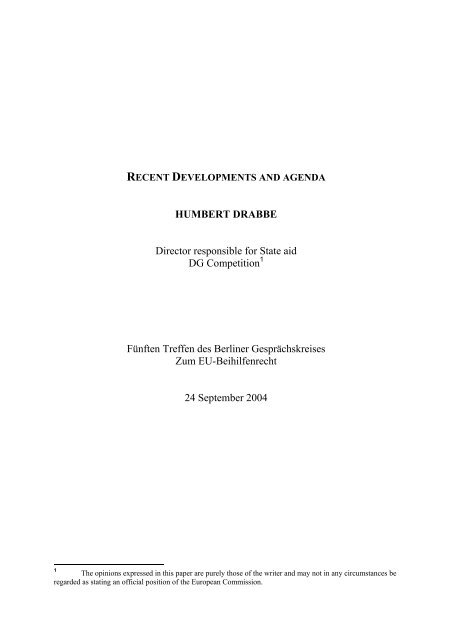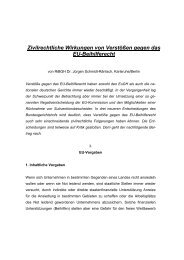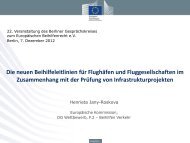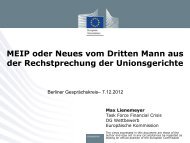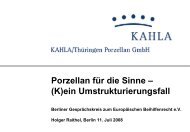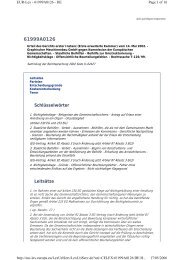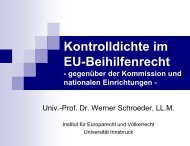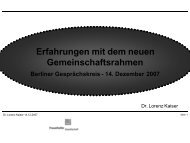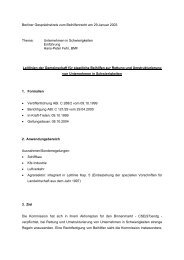HUMBERT DRABBE Director responsible for State aid DG ...
HUMBERT DRABBE Director responsible for State aid DG ...
HUMBERT DRABBE Director responsible for State aid DG ...
Create successful ePaper yourself
Turn your PDF publications into a flip-book with our unique Google optimized e-Paper software.
RECENT DEVELOPMENTS AND AGENDA<br />
<strong>HUMBERT</strong> <strong>DRABBE</strong><br />
<strong>Director</strong> <strong>responsible</strong> <strong>for</strong> <strong>State</strong> <strong>aid</strong><br />
<strong>DG</strong> Competition 1<br />
Fünften Treffen des Berliner Gesprächskreises<br />
Zum EU-Beihilfenrecht<br />
24 September 2004<br />
1 The opinions expressed in this paper are purely those of the writer and may not in any circumstances be<br />
regarded as stating an official position of the European Commission.
Introduction<br />
Let me first thank you <strong>for</strong> giving me the opportunity to speak at the fifth<br />
meeting of the Gesprächskreise. The timing of this meeting is such that we find<br />
ourselves at the end of the mandate of the Prodi Commission and at the start of<br />
the new Commission. The obvious question at this juncture is whether there<br />
will be changes in the Commission’s state <strong>aid</strong> policy. To answer that question<br />
with certainty would be premature as the new Commission is not yet in place<br />
and still has to fix its policies. But state <strong>aid</strong> policy, as other policies, is of course<br />
characterized by a large degree of continuity. There is there<strong>for</strong>e a basis from<br />
which I can start to indicate what can be expected in the future.<br />
The two main driving <strong>for</strong>ces in state <strong>aid</strong> policy during Mr Monti’s mandate have<br />
been enlargement and the Lisbon agenda. It is safe to assume that they will<br />
continue to be so. In my contribution today I will there<strong>for</strong>e place recent<br />
developments in state <strong>aid</strong>s and expected actions <strong>for</strong> the future in this context.<br />
The principal mission of <strong>DG</strong> COMP is to carry out the en<strong>for</strong>cement of the<br />
competition rules on merger control, antitrust and <strong>State</strong> <strong>aid</strong> control.<br />
Making effective competition play is an important means to increase the<br />
competitiveness of industry, to produce wealth <strong>for</strong> society and to provide<br />
consumers with an enlarged choice of better quality goods. There<strong>for</strong>e, the main<br />
purpose of a competition authority is that of ensuring or creating conditions<br />
which enable the market to function in a competitive way.<br />
In addition to this, European competition policy has a unique specificity. It has<br />
been designed crucially to help the creation of an internal market which shows<br />
the characteristics of a single market. Indeed, competition policy is a key<br />
instrument to avoid that public barriers to trade, that the Community<br />
construction aims to abolish, are re-established in the <strong>for</strong>m of private<br />
agreements, self regulation or public interventions.<br />
Competition policy should also provide an essential contribution to the<br />
political priorities of the new Commission, and particularly that of boosting<br />
the economy and achieving sustainable economic growth, by means of<br />
reinvigorating the Lisbon process. There is a clear link between encouraging<br />
more competition in Europe and achieving a better per<strong>for</strong>ming economy. Open<br />
and competitive EU markets will make European companies more competitive<br />
internationally to the benefit of consumers and of European employment. In<br />
response to the Lisbon agenda, the Commission is progressively implementing a<br />
series of re<strong>for</strong>ms in order to refocus its <strong>State</strong> Aid policy towards a more<br />
economic approach which aims at eliminating real distortions of competition<br />
resulting from <strong>State</strong> intervention.<br />
- 2 -
It should also be noticed that the accession of ten new Member <strong>State</strong>s adds a<br />
further geographical dimension to the goal of improving economic growth in the<br />
internal market. Broadening the internal market and bringing in the economies<br />
of the new members are crucial to a successful enlargement.<br />
A first priority should be to focus en<strong>for</strong>cement on state <strong>aid</strong>s which are most<br />
harmful <strong>for</strong> the European economy. In practice this means an increased focus<br />
on the economic effects of state <strong>aid</strong> on trade and competition so as to identify<br />
the most distortive <strong>aid</strong>s. The proposal <strong>for</strong> a Significant Impact Test, identifying<br />
<strong>aid</strong>s of lesser importance, also stems from this approach in that it introduces a<br />
fast track procedure <strong>for</strong> such <strong>aid</strong>s.<br />
Second priority should be given to ensuring favourable conditions <strong>for</strong><br />
competitiveness and cohesion, in line with the Lisbon strategy. The<br />
<strong>for</strong>thcoming review of the Regional Aid Guidelines and a number of other<br />
horizontal measures is instrumental in achieving this objective.<br />
Third priority should be to continue to focus en<strong>for</strong>cement on key sectors <strong>for</strong><br />
the Internal Market and <strong>for</strong> implementing the Lisbon strategy. In<br />
particular, emphasis should be put on removing obstacles to competition in<br />
recently liberalised sectors like telecommunications, postal services, energy and<br />
transport. These sectors provide essential inputs to many other sectors and are<br />
of key importance <strong>for</strong> Europe’s competitiveness. However, they are affected by<br />
various distortions to competition including state <strong>aid</strong>s. In removing obstacles to<br />
competition, however, due consideration should be provided to the fact that<br />
these sectors are characterised by important public service obligations, with a<br />
view to providing services of general economic interest. These obligations must<br />
be preserved as they guarantee that the services remain af<strong>for</strong>dable and accessible<br />
to all users. This is essential to safeguarding a socially inclusive society, which<br />
is another dimension of the concept of sustainable growth.<br />
Finally, we should give priority to state <strong>aid</strong> advocacy in cooperation with<br />
Member <strong>State</strong>s and within the Commission to raise awareness and acceptance of<br />
state <strong>aid</strong> policy as an instrument to achieve the main policy objectives I referred<br />
to right at the start.<br />
Specific measures taken<br />
As I s<strong>aid</strong> continuity is also an important element in state <strong>aid</strong> policy. In the runup<br />
to enlargement we have reviewed state <strong>aid</strong> procedures with a view to making<br />
them more efficient and effective.<br />
- 3 -
Earlier this year the Commission adopted the new regulation implementing the<br />
Procedural Regulation. It will enter into <strong>for</strong>ce on 1 October.<br />
The new regulation lays down detailed rules as regards notification of <strong>State</strong> <strong>aid</strong><br />
to the Commission, time limits, annual reports and the interest rates to be used<br />
<strong>for</strong> recovery purposes.<br />
Among the key elements are:<br />
- the establishment of comprehensive notification <strong>for</strong>ms, which will<br />
become compulsory;<br />
- new simplified notification requirements <strong>for</strong> minor changes to <strong>aid</strong><br />
schemes;<br />
- simplified annual reporting requirements which are intended to accelerate<br />
the collection of data <strong>for</strong> the scoreboard;<br />
- clear rules on interest rates <strong>for</strong> recovery.<br />
If I go into detail it is because we hope that this regulation will substantially<br />
simplify procedures and reduce the time necessary to approve notified <strong>aid</strong>. In<br />
particular, and provided Member <strong>State</strong>s use the new <strong>for</strong>ms correctly, the need<br />
<strong>for</strong> additional questions and lengthy investigations should be greatly reduced.<br />
The Commission has also decided to <strong>for</strong>mally repeal a large number of older<br />
communications and soft law texts on procedural matters which have now<br />
become redundant and can no longer be relied on.<br />
A new communication aims to give clear guidance on how the Commission will<br />
deal with requests not to publish in<strong>for</strong>mation <strong>for</strong> reasons of confidentiality, and<br />
new internal procedures have been established to deal with these requests.<br />
Finally, as regards procedures we will be cutting red tape by introducing<br />
electronic notification, hopefully by the end of next year and by further<br />
developing the electronic network with MS (called CIRCA).<br />
The European Councils in 2000 and 2001 set the objectives of reducing overall<br />
<strong>aid</strong> levels and of redirecting <strong>aid</strong> to horizontal objectives of common interest. As<br />
such, this would seem to warrant <strong>for</strong> a stricter approach towards the more<br />
distortive <strong>for</strong>ms of <strong>aid</strong>, such as <strong>aid</strong> <strong>for</strong> firms in difficulty. The exit of inefficient<br />
firms is a normal part of the operation of the market. It cannot be the norm that<br />
a company which gets into difficulties is rescued by the <strong>State</strong>. On the other<br />
hand the Council conclusions require that we modernise our regional <strong>aid</strong><br />
guidelines and other horizontal instruments. As regards the new regional <strong>aid</strong><br />
guidelines, those should allow <strong>for</strong> a better concentration of regional <strong>aid</strong> on the<br />
least favoured regions, while increasing flexibility <strong>for</strong> pursuing development<br />
policies <strong>for</strong> other regions. In the same context, we will work on adapting our<br />
- 4 -
other horizontal rules to facilitate innovation, R and D, and access to risk capital<br />
to strengthen durably the growth potential of regions.<br />
Let me try to illustrate these points by commenting on some of our proposals.<br />
The new guidelines <strong>for</strong> Rescue and Restructuring <strong>aid</strong>, adopted on 17<br />
September and entering into effect on 10 October, reflect this policy line <strong>for</strong><br />
instance by rein<strong>for</strong>cing the application of the “one time, last time” principle and<br />
by the maximum period of 6 months <strong>for</strong> rescue <strong>aid</strong>.<br />
I just like to point out that the greater concern with the economic rationale of our<br />
decisions is reflected in the wider scope <strong>for</strong> compensatory measures.<br />
Traditionally, these would focus on divestments or capacity reductions i.e. on<br />
undoing primarily the effect of the <strong>aid</strong> on competitors. The new guidelines<br />
explicitly include now measures to strengthen market access which addresses<br />
more general competition concerns. The new guidelines also create more<br />
transparency in that they clarify a number of points which led to questions of<br />
interpretation in the past.<br />
The focus on most harmful <strong>aid</strong>s based on a more economic analysis of the<br />
effects of state support on trade and competition has led to the proposal <strong>for</strong> a<br />
Significant Impact Test.<br />
It should allow MS more flexibility in implementing <strong>aid</strong> measures that have only<br />
limited effects on competition and trade. The underlying reasoning is that<br />
relatively small amounts of <strong>aid</strong> are likely to have a limited effect on trade and<br />
competition taking into account other factors such as the limited tradability of a<br />
given activity, the competitive structure of the market concerned, the possible<br />
market power of the beneficiaries and the availability in the market.<br />
A new framework would provide <strong>for</strong> a simplified assessment (LASA-test) of up<br />
to 1 million Euro of <strong>aid</strong> granted in pursuit of Community objectives such as R &<br />
D, innovation, training, risk capital, regional <strong>aid</strong>, employment and development<br />
of SMEs. Where the R+R guidelines reflect in particular the drive towards<br />
reduction of distortive <strong>aid</strong>s, the SIT thus reflects the other objective of<br />
refocussing state <strong>aid</strong> policy on the basis of a more economic approach and give<br />
MS more scope to adopt horizontal measures in line with Community<br />
objectives.<br />
Following discussions with MS we have considerably reduced the reporting<br />
requirements <strong>for</strong> MS so as to avoid too heavy an administrative burden on<br />
companies and administrations, which is after all one of the SIT objectives. The<br />
framework will also set out some general orientations <strong>for</strong> the assessment of<br />
other types of <strong>aid</strong> which are not likely to produce significant effects on trade.<br />
- 5 -
They are the same as I just mentioned <strong>for</strong> the LASA-test. The SIT will not<br />
anymore be submitted <strong>for</strong> adoption to the outgoing Commission.<br />
In order to simplify the rules which are particularly important <strong>for</strong> SMEs, we will<br />
consolidate the existing block exemption regulations into one regulation.<br />
Adoption is planned <strong>for</strong> 2006 and will take into account the results of the<br />
discussions on the new Regional Aid Guidelines, on R and D and Innovation,<br />
and risk capital. This means that at the same time the scope of block exempted<br />
<strong>aid</strong> may well increase. If Parliament agrees to the principle we may also exempt<br />
small scale services of general economic interest from the notification obligation<br />
by end 2005.<br />
As regards the Regional Aid Guidelines, in a nutshell, the main challenge <strong>for</strong> the<br />
future is to redefine regional <strong>State</strong> <strong>aid</strong> policy in an enlarged Union, reconciling<br />
the overall reduction of <strong>aid</strong> volumes with the Community objective of economic<br />
and social cohesion. The revision of the existing regional <strong>aid</strong> guidelines is not<br />
an isolated issue, but has to be conceived as an essential part of the general<br />
re<strong>for</strong>m of <strong>State</strong> <strong>aid</strong> policies towards less and better targeted <strong>aid</strong>. At the same<br />
time, it will need to be inspired by the conclusions of the European Councils of<br />
Lisbon and Stockholm, calling upon the Commission to give clear priority to the<br />
least developed regions in con<strong>for</strong>mity with the exceptional nature of regional<br />
<strong>State</strong> <strong>aid</strong>, and to take full account of the conclusions of the Third Report on<br />
Cohesion Policy.<br />
The Third Cohesion Report lays down the foundations <strong>for</strong> a new cohesion policy<br />
by moving towards an approach which is less territorial and providing all the<br />
regions with the necessary flexibility to tackle local problems and address their<br />
competitiveness gap, in pursuit of key community priorities linked to the Lisbon<br />
and Gothenburg agendas.<br />
In this context, the main policy objectives of the revision of the regional <strong>aid</strong><br />
guidelines, which fits within the general move towards a more economic<br />
approach to <strong>State</strong> <strong>aid</strong> policy, are threefold: achieving concentration of regional<br />
<strong>aid</strong> to investment in the least favoured regions, ensuring an adequate margin of<br />
flexibility <strong>for</strong> Member <strong>State</strong>s and regions to pursue local regional policy, and<br />
enhancing the long-term competitiveness and growth potential of all European<br />
regions.<br />
In practice these objectives translate into:<br />
• A strict concentration of regions eligible <strong>for</strong> regional <strong>aid</strong> on those regions<br />
most in need;<br />
• A substantial reduction of <strong>aid</strong> intensities <strong>for</strong> regional investment projects<br />
- 6 -
• The possibility to grant <strong>aid</strong> under the horizontal instruments which will be<br />
reviewed in the light of the Lisbon agenda to facilitate innovation, R and D,<br />
and access to risk capital <strong>for</strong> SMEs. This review will also block exempt<br />
investment <strong>aid</strong> <strong>for</strong> SMEs located in non-assisted regions. The Significant<br />
Impact Test is intended to provide an additional element of flexibility, also in<br />
regions which will no longer be assisted areas under art. 87(3)c.<br />
The proposed new RAG imply an important change from earlier policy and,<br />
predictably, have led to a rather mixed set of critical comments.<br />
For instance, where the new MS argue against a reduction of <strong>aid</strong> intensities,<br />
others plead <strong>for</strong> a further reduction as they fear <strong>for</strong> delocalisation of large firms<br />
or firms in border regions.<br />
The proposed thematic (horizontal) approach is questioned, as it might not<br />
provide an adequate alternative <strong>for</strong> the existing possibilities to grant investment<br />
<strong>aid</strong> in today’s C-regions, including <strong>aid</strong> to large firms. Some prefer to have it<br />
both ways: maintain the map-based approach and benefit from an increased<br />
flexibility under the horizontal rules.<br />
Finally, a number of MS would prefer to have a complete picture of the review<br />
of all horizontal measures and of the structural fund regulation, be<strong>for</strong>e taking a<br />
final view.<br />
All this means that the new Commission has quite a challenge in front of it in<br />
finalizing its proposal. And it is likely that further discussions and consultations<br />
will take a good part of next year and that the pieces of this jig-saw puzzle are<br />
likely to fall in place at a fairly late stage.<br />
At the moment we are busy analyzing the comments by MS with a view to<br />
identify what changes should and could be made within the context of the<br />
overall Lisbon-based policy objectives.<br />
As regards the review of the horizontal frameworks our timing is to finalize a<br />
communication on innovation by mid next year, and to have the new R and D<br />
framework and the revised Communication on risk capital adopted by end 2005,<br />
together with the RAG. This should coincide globablly with the “super” block<br />
exemption regulation and the exemption regulation <strong>for</strong> small scale services of<br />
general economic interest. This is a quite ambitious programme, you will<br />
realise, but I expect that the proposed texts will be available in time so as not to<br />
slow down decision making on the RAG.<br />
- 7 -
<strong>State</strong> <strong>aid</strong> advocacy<br />
I mentioned state <strong>aid</strong> advocacy as a priority. <strong>State</strong> <strong>aid</strong> advocacy plays at two<br />
levels.<br />
First, it aims at better integrating state <strong>aid</strong> policy in other EU policies and its<br />
focus should there<strong>for</strong>e be with intensifying the policy dialogue in house.<br />
Second, and of more direct interest to you, it aims at raising awareness and<br />
acceptance of state <strong>aid</strong> policy with stakeholders such as MS, industry, national<br />
courts and others, including the general public. Certainly in an enlarged Union,<br />
raising awareness and acceptance is crucial in order to ensure the continued<br />
effectivess of state <strong>aid</strong> policy. In comparison with antitrust and mergers, <strong>State</strong><br />
Aid en<strong>for</strong>cement does not rely on a network of national competition authorities<br />
en<strong>for</strong>cing competition policy at national level, raising awareness and acceptance<br />
of the role of competition policy. More in general, it would seem that state <strong>aid</strong><br />
policy is a relatively unknown area of competition policy, as shown, <strong>for</strong><br />
example, by the low number of cases be<strong>for</strong>e national courts.<br />
It would seem that there is a least one important factor which contributes to this<br />
situation. Where in antitrust the stakeholders are a relatively well defined group<br />
(industry, legal profession, courts) this is much less so in state <strong>aid</strong>s. Authorities<br />
granting <strong>aid</strong> may be at national, regional or local level or even be public<br />
undertakings. In many MS there is no clear coordination between these<br />
authorities or no central point in the administration channeling notifications or<br />
making a state <strong>aid</strong> assessment be<strong>for</strong>e notification. At EU level we meet MS in<br />
the so-called multilateral meeting to discuss our proposals <strong>for</strong> frameworks etc.<br />
but there is no appropriate body <strong>for</strong> a more general policy dialogue as it exists<br />
<strong>for</strong> antitrust and mergers.<br />
One crucial factor to raise at least awareness, if not acceptance, is of course by<br />
strengthening transparency as regards procedures, legal texts and by providing<br />
in<strong>for</strong>mation on the results of state <strong>aid</strong> policy. On the Commission side I have<br />
referred to the measures to make state <strong>aid</strong> procedures more efficient and clear.<br />
In reviewing our horizontal rules we pay and will pay attention to produce clear<br />
texts and as consistent and straight<strong>for</strong>ward as possible, although there will<br />
always be some scope <strong>for</strong> interpretation. On a practical point, the <strong>State</strong> Aid<br />
website will be made more user-friendly and give access to all decisions taken,<br />
be<strong>for</strong>e they will be published in the Official Journal.<br />
The Scoreboard and the Register are now well established and have contributed<br />
importantly to make state <strong>aid</strong>s more visible as to its results and effects. We will<br />
also continue to use the yearly multilateral meeting discussing the Scoreboard<br />
and as a <strong>for</strong>um to exchange ideas and develop benchmarks to promote the<br />
effectiveness of <strong>aid</strong>.<br />
- 8 -
We will continue to improve our transparency enhancing measures in order to<br />
provide a basis <strong>for</strong> an effective state <strong>aid</strong> advocacy in order to ensure the<br />
continued effectiveness of state <strong>aid</strong> policy in the enlarged Union.<br />
As regards the MS, the last multilateral meeting showed that quite a number of<br />
them are taking steps to get a better overview of <strong>aid</strong> measures and to achieve a<br />
more coordinated and consistent approach. Some MS have already introduced a<br />
<strong>for</strong>m of coordinated state <strong>aid</strong> assessment when considering a new measure.<br />
From the Commission’s viewpoint such a development can only be welcomed<br />
as it implies an increased awareness and acceptance of state <strong>aid</strong> rules. But also<br />
since it is more efficient to deal with state <strong>aid</strong> issues more up-front, i.e. be<strong>for</strong>e it<br />
becomes more difficult to withdraw or revise a measure. From our side, where<br />
we can be of help at an early stage of decision-making, we continue to be<br />
available to try to clarify any state <strong>aid</strong> issues that may arise.<br />
* * *<br />
- 9 -


